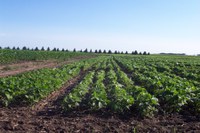NDSU Increasing the Economics of Raising Soybeans
(Click the image below to view a high-resolution image that can be downloaded)
Of broadleaf crops grown in North Dakota, soybeans will continue to be the leader in acreage in 2011.
To improve soybean yields economically, producers are exploring combinations of production management strategies. North Dakota State University is conducting several research trials to assist with this goal in mind, according to Greg Endres, NDSU Extension Service area agronomist at the Carrington Research Extension Center, and Hans Kandel, NDSU Extension Service agronomist in Fargo.
A soybean intensive management study has been conducted since 2008 to examine combinations of planting rates, row spacing and special foliar inputs using early and late-maturing varieties to identify the most profitable combination. Best management practices are used in the study, including seed inoculation and seed fungicide/insecticide treatments.
Six site-years of data have been generated from trial locations at Carrington and Prosper.
“Planting rates of 150,000 and 200,000 pure live seeds (PLS) per acre have been compared with an average early season established stand of 138,000 and 175,000 plants per acre, respectively,” Endres says. “NDSU currently recommends an established soybean stand of 150,000 plants per acre, with a variance of 10 percent, to maximize yield potential. Current results from the study indicate a yield advantage of just less than 1 bushel per acre, or 1.5 percent, averaged across site-years for the high planting rate. However, when costs and benefits are calculated, the lower planting rate is more economical.”
Fourteen-inch row spacing has averaged 1.1 bushels per acre or about a 2 percent greater yield than using 28-inch rows.
“This confirms other university data indicating a higher yield potential with intermediate rows versus wide rows,” Kandel says. “Also, in the NDSU study, canopy closure occurred an average of a month earlier with the 14-inch rows, compared with wide rows. Quicker canopy closure provides advantages, including greater weed competition, soil moisture conservation and increased capture of sunlight, all potentially resulting in higher yields using the narrower rows.”
Special foliar inputs, including a nutrient combination, plus a growth promoter at early vegetative stages, were applied sequentially. This was followed by a fungicide treatment during the flowering to early-pod formation stages. Across site-years, the special inputs increased soybean yield 2.2 bushels per acre, or about 4 percent, compared with the untreated check. However, there only was a modest return on investment.
“In another ongoing study conducted at Carrington to examine special inputs for soybeans, numerous individual products or combinations applied at various plant stages have not consistently provided yield gain or economic returns,” Endres says. Farmers should use caution when considering additional inputs beyond recommended management practices that are based on university research.”
Study results indicate the combination of planting 150,000 PLS per acre in 14-inch rows, followed by the combination of special foliar inputs, provides the highest return on investment among the options explored.
The intensive management study will be continued this crop season at Carrington and Fargo.
“This year, an addition to the research is comparing soybean performance under tiled versus undrained soil environments at Fargo,” Kandel says. “In addition, other soybean production management studies are planned in 2011 to continue investigating soybean response to other factors, including tillage systems, planting dates, fertilizer placement, seed inoculation and special inputs.”
The research is being supported by the North Dakota Soybean Council.
NDSU Agriculture Communication - April 29, 2011
| Source: | Greg Endres, (701) 652-2951, gregory.endres@ndsu.edu |
|---|---|
| Source: | Hans Kandel, (701) 231-8135, hans.kandel@ndsu.edu |
| Editor: | Rich Mattern, (701) 231-6136, richard.mattern@ndsu.edu |


